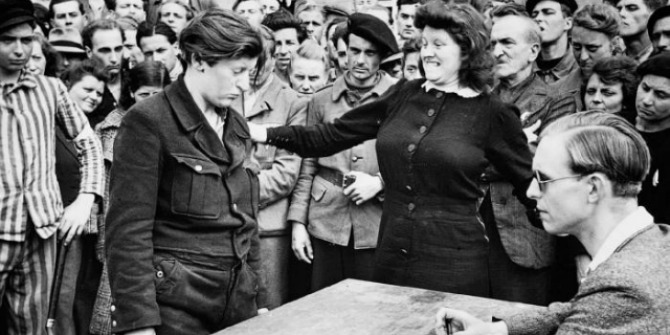The Gestapo aims to trace the story of the Nazis’ secret police force, mostly remembered as the infamous epitome of Nazi terror and oppression. Tracing the history of the organization from its origins in the Weimar Republic, through the crimes of the Nazi period, to the fate of former Gestapo officers after World War II, Carsten Dams and Michael Stolle question the myths that have long surrounded the Gestapo. This serves as a cautionary tale about the extremes of preventative policing and the role of intelligence in today’s troubled world, writes Lauren Young.
 The Gestapo: Power and Terror in the Third Reich. Carsten Dams and Michael Stolle (trans. by Charlotte Ryland). Oxford University Press. 2014.
The Gestapo: Power and Terror in the Third Reich. Carsten Dams and Michael Stolle (trans. by Charlotte Ryland). Oxford University Press. 2014.
In the age of controversy about WikiLeaks, Edward Snowden, and NSA eavesdropping as a tool of counter terrorism, The Gestapo: Power and Terror in the Third Reich serves as a timely reminder of the terrifying excesses of state security. Carsten Dams (Professor of Police Sciences at the School of Public Management of North-Rhine Westphalia) and Michael Stolle’s (Karlsruhe Institute of Technology) meticulously researched work benefits from the recent release of SS archives to produce a taxonomic examination of the evolution of the Gestapo during its short 12-year history, from a bureaucratic regional police force to a unified superstructure with seemingly limitless powers of intimidation and death. This book raises questions about how the Gestapo came to embody the evil of the Third Reich, what sustained its campaign of annihilation, and perhaps most interestingly, what happened to the legions of soldiers who were part of the Gestapo, but not formally prosecuted post WWII.
The Gestapo was established in April 1933 when Himmler assumed the position of “Commander of the Bavarian Political Police, appointing Reinhard Heydrich as his Deputy Head (p.11). By August 1936, a Gestapo presence was established throughout Germany, mostly through collaboration with local police forces. While the Gestapo was presided over by civil servants, it “gained the highest possible level of autonomy in relation to the state administration” ( p. 17). With Himmler, Heydrich, and later Goring and Diehls at its helm, came “a process of ideological transformation which had widespread effects” (p. 29), most notably that Gestapo authority was no longer derived “out of the state, but out of the people.” (p. 29) Thus, the execution of Hitler’s inviolable call for Germany to be a “community of physically and psychologically homogenous beings” (p. 29), as set out in Mein Kampf, served as a justification for the supra State function which the Gestapo quickly adopted.
The backgrounds of Gestapo leaders are notable. In 1938, “95% of Gestapo chiefs…had completed their school leaving exams, 87% had then studied law, and half of them had doctorates” (p. 47). The backgrounds of the rank and file were more varied, which lead to minor tensions in the early years. Gestapo ranks swelled to as many as 15,000 officers early in the war (p. 34). Characterized by a system of rapid promotions, Gestapo positions were sought after by the young and ideologically driven, which the authors postulate ramped up the “process of radicalization” (p. 52) and resulted in an increasingly brutal regime. The concomitant lack of disciplinary oversight was, according to the authors, intentional. As the Gestapo became more radicalized, “the perpetrators, then, did not view themselves as murderers or sadists, but as having a serious task to fulfill” (p.55): the adherence to Hitler’s call for ethnic cleansing.
Dams and Stoller also examine the auxiliary forces which helped the Gestapo to cement their power. Both informants and denunciations played a key role in extending the Gestapo’s reach. The Gestapo threatened the families of Jewish informants such as the infamous Stella Kubler and Rolf Isaakson, who were forced to befriend Jews hiding in Berlin with promises to assist them, only to turn them over to the SS. Kubler was deemed responsible for the deaths of as many as several hundred Jews (p.71). Despite her collaboration, Kubler’s own family still perished.

Recent scholarship has also established the importance of denunciations in the Gestapo grip on power. The willingness of ordinary citizens to identify anyone who did not purportedly adhere to Nationalist Socialist principles was not uniquely a German phenomenon. Widespread denunciations, mostly made by men, played an important role in Gestapo persecution not just in Germany, but in occupied Poland and in France as well (p. 70). Local populations, encouraged by aggressive Nazi propaganda to denounce non-adherents, functioned as a “society under its own surveillance” (p.75). The cooperation of other government agencies such as local police forces and state administrations similarly bolstered the Gestapo’s absolute power, acting as local operators within communities, communicating their “intelligence” to the Gestapo hierarchy. As such, “the persecution was so effective because it was not carried out solely by the Gestapo in the narrow sense. It was largely this extended network, these ‘assistant doctors’, that made the Gestapo’s investigations successful” (p. 84).
Perhaps the newest and most troubling contribution to the vast Gestapo literature is Dams and Stoller’s conclusion which dispels the myth that former Nazis and the Gestapo in particular were extinguished after WW2. In fact, according to the authors, the former SS easily found employment in both the GDR and FDR, often rising to senior levels in government and benefitting from national State pensions and benefits. While the Nuremberg Trials and de-Nazification are both relatively well-trodden academic territory, the authors unveil a more disturbing history of the reintegration of former Gestapo agents into the civil service networks in both West and the Former East Germany. Some Nazis such as Adolf Eichmann or Klaus Barbie escaped to South America amidst the confusion of post war Europe, with Barbie even later emerging as a CIA operative in Bolivia (pp. 158-159). While the UN War Crimes Commission, established as early as 1942, did net many of the most notorious Gestapo and tried them at Nuremberg, the authors contend that these were only the highest ranking officers were prosecuted and not necessarily the rank and file. In addition, the Eichmann defense – following orders with no recourse, the “banality of evil” as written by philosopher Hannah Arendt – was also a common defense among lesser ranking perpetrators who were subsequently barely punished. Many perpetrators simply evoked this defense, or were not tried. Legislation such as a law passed in the FDR in 1948 “amnestied all crimes committed before 15 September 1949 for which the punishment was less than six months” (p. 166) provided an easy escape from retribution. It is estimated that as many as 700,000 former Nazis and SS benefited from this law (p. 167).
In an era of terrorism, often propagated by a changing roster of non-state actors, Dams and Stolle’s book also serves as a cautionary tale about the extremes of preventative policing and the role of intelligence in today’s troubled world. As such, this book not only offers a detailed study of the 12-year Gestapo reign of terror, but offers disturbing evidence about how the Gestapo assimilated back into German society, both East and West, after WWII. Recalling the Gestapo “Modus Operandi” serves as a reminder that the justifications for “pre-emptive control and increased surveillance” (p. 182), as well as torture propagated by the government, were also hallmarks of the Nazi regime.
Lauren Young currently teaches International History at the London School of Economics. Prior to that, she was a Fellow at the US Department of State working both at the UN Security Council and the US Embassy in London. Read more reviews by Lauren.






1 Comments